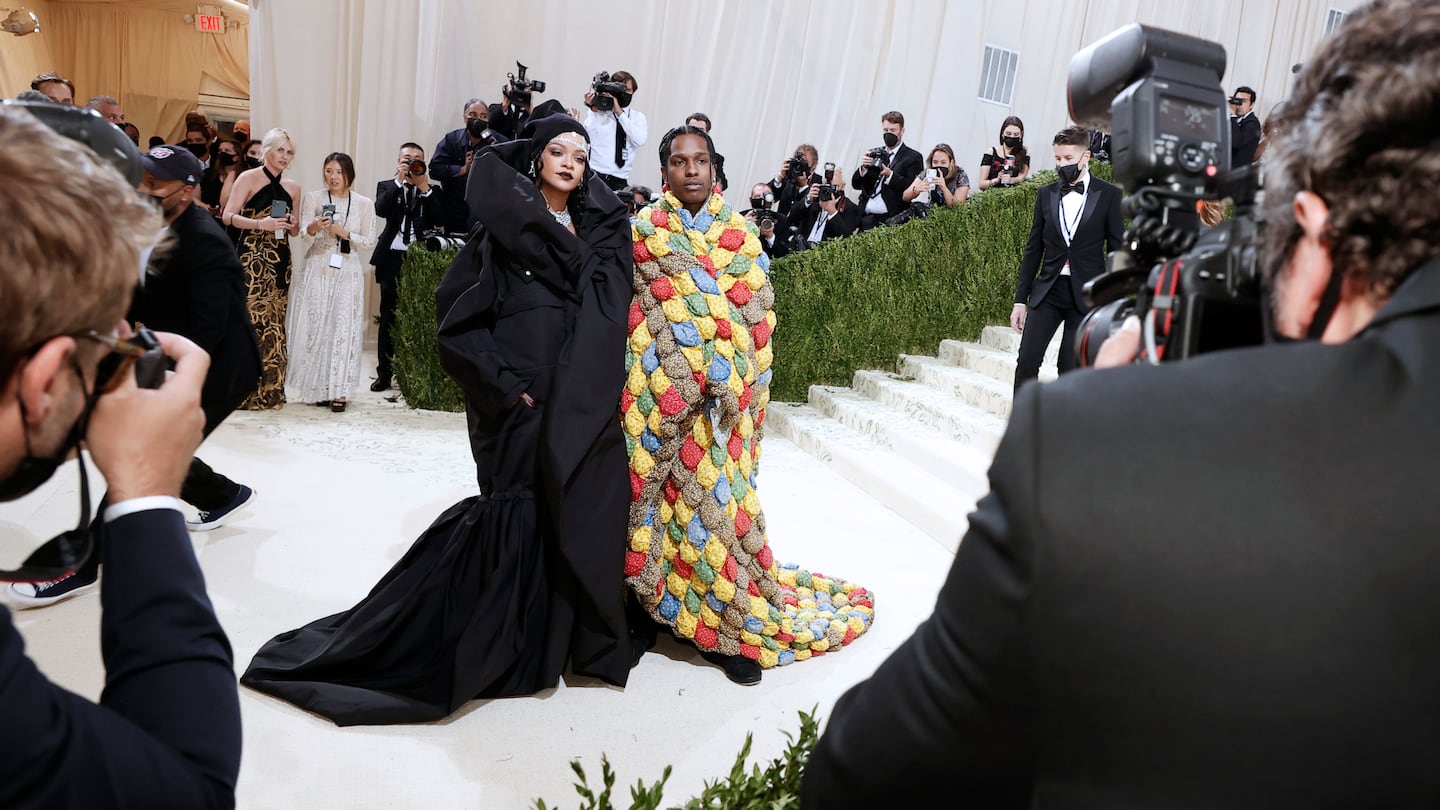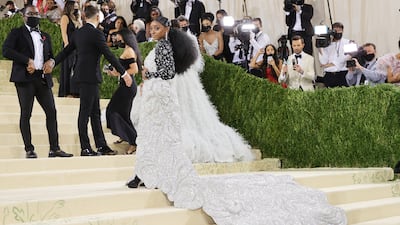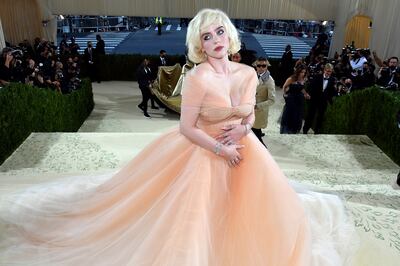
The Business of Fashion
Agenda-setting intelligence, analysis and advice for the global fashion community.

Agenda-setting intelligence, analysis and advice for the global fashion community.

More than a year after it was first canceled and amid a spike in Covid cases, fashion’s most exclusive party made an unlikely return on Monday night, this time with a smaller and younger guest list than years prior. The Met Gala lacked the same level of star power and viral moments as it delivered in recent years, but it filled in some of the gaps with a wider range of athletes, politicians, designers and social media stars than usually get the chance to attend the prestigious gathering hosted by The Costume Institute at the Metropolitan Museum of Art and Vogue’s Anna Wintour.
Among the attendees who made a memorable entrance were Olympic champion gymnast Simone Biles, who arrived in a layered crystal beaded showgirl-inspired gown that resembled feathers, featuring a long train and accentuated hips. The look was created by Area, a lesser-known New York-based label designed by Beckett Fogg and Piotrek Panszczyk.
Others who interpreted the dress code of “American independence” with homegrown designers included Lorde in an embroidered silk set by another smaller label, Bode, and co-host Billie Eilish, who commissioned an old Hollywood-inspired ball gown from Oscar de la Renta. Wintour broke from her usual choice, Chanel, and also went with Oscar de la Renta. Thom Browne outfitted almost a dozen people, including Sharon Stone and Pete Davidson, while Jennifer Lopez turned to Ralph Lauren for a western wear look. Zac Posen designed a tattered American flag skirt and denim jacket for guest Debbie Harry.

But there was little commonality in the interpretations of the theme and few effective political statements. Congresswoman Alexandria Ocasio-Cortez wore a white gown by Brother Vellies emblazoned with the words “Tax the Rich” that garnered criticism for hypocrisy online.
ADVERTISEMENT
And there was no shortage of guests dressed in European luxury designer looks with no ostensible connection to the dress code. Two of the most highly anticipated guests of the night, Rihanna and Kim Kardashian, both opted for somber, striking looks from Balenciaga. Versace and Valentino dressed half a dozen or more guests each. Meanwhile, designers like Marc Jacobs and Telfar and stars like Beyoncé and Lady Gaga were among the notable no-shows.
The Met Gala has long been a way for Vogue — and Wintour — to assert its role as the most authoritative voice in fashion and grant a select group of celebrities and designers a powerful spotlight.
But this year, with gatekeeping officially out of style and with Covid still keeping parties restricted, the Gala was something of an opportunity for fashion’s establishment to prove its party is still relevant in a more digital and progressive age. The results were mixed, and won’t likely be evident until next May, when the Met Gala plans to return to its original schedule and its full scale.
Covid restrictions and travel bans kept some typical Met Gala guests away, including many European designers and stars who were rumoured or confirmed to be unvaccinated like Nicki Minaj, who tweeted “if I get vaccinated it won’t be for the Met” as the red carpet kicked off.
Wintour timed the Met Gala’s return as a dramatic closure to the first in-person New York Fashion Week since the pandemic, which came to a close on Sunday, and as a statement showing New York City and its fashion community was back. The schedule put pressure on designers — many of whom balanced preparing for the event with staging their runway shows — who worried that the Met Gala coverage would overshadow fashion week.

This year’s Met Gala was also its most digitally accessible, thanks in large part to the main sponsor of the evening, Instagram. The Facebook-owned social media app has disrupted fashion’s designers, retailers and publishers by becoming the place where people head to discover fashion and, for many people over the last year, the only reason to get dressed up. It’s increasingly become a destination for actual shopping, too.
(In a testament to how much times have changed, the last time The Costume Institute explored an American fashion theme, in 2010, Gap was the sponsor and the exhibit focused on gowns worn by heiresses at the turn of the twentieth century and the flapper era.)
Instagram’s head Adam Mosseri and director of fashion partnerships Eva Chen hosted an extra-large table at the Met Gala, including musician Kid Cudi and Marvel actor Simu Liu, along with two of the most talked-about young American designers right now: Christopher John Rogers and Pyer Moss’ Kerby Jean-Raymond.
ADVERTISEMENT
It was Rogers whose work took prime position in “In America: A Lexicon of Fashion,” the exhibition curated by Andrew Bolton and opening Saturday. His plaid silk taffeta gown, from the autumn 2020 collection, occupied one of the largest spaces at the foot of the stairs inside the Anna Wintour Costume Center, where 100 objects from a range of American and US-based designers, including Andre Walker, Oscar de la Renta, Bonnie Cashin and Hood by Air, were displayed. It even marked Rihanna’s first inclusion in a Met exhibit, by way of one of her lingerie designs for Savage X Fenty.
Many of the newer, lesser-known designers included in the exhibit were able to attend the Met Gala for the first time because every table, regardless of sponsor, hosted at least one emerging designer. Eckhaus Latta’s Mike Eckhaus and Zoe Latta attended as guests of Nordstrom, for example, while Willy Chavarria came with YouTube and Theophilio’s Edvin Thompson joined a table bought by Formula One driver Lewis Hamilton.
The exhibit fêted Monday is the first part of an exploration of American fashion that aims to show how it is more than just the practical sportswear for which it is so well known, Bolton said at the museum’s preview on Monday morning. The second, larger exhibit will open in May 2022, when the Met Gala plans to return to its normal schedule.

Instagram, which will also sponsor the second exhibit and Met Gala next year, flexed its muscles beyond just hosting one of the largest tables of the evening. The app beefed up its coverage of the event, enlisting popular meme accounts like Saint Hoax (technically the event’s official " meme correspondent”), The Shade Room and Slutty Puffin, as well as critics and commentators, to create content about the red carpet that crescendoed with questions about whether Rihanna would arrive (she did, fashionably late). Inside the museum, Instagram set up its typical photo booth for guests to create Reels, its newest feature that mimics TikTok’s short-form videos.
And in the week leading up to the gala, Instagram dropped the first of nine monthly Met Gala capsule collections on the app, where much of the first instalment by Off-White sold out during a shoppable livestream hosted by Chen and designer Virgil Abloh.
“Seeing the content mixed effortlessly with the commerce aspect of the merch is going to be something really interesting,” said Chen. “The borders might be closed, people might not feel comfortable travelling, but they’ll be able to experience the Met Gala and the exhibit in their own way.”
As was to be expected, all the digital bells and whistles set off a bit of a panic, reportedly, that the Met Gala was losing its cachet, as verbalised by the New York Post, and that the influx of influencers scared off A-listers. It’s a criticism that Vogue has faced before, notably when it allowed Kim Kardashian to attend for the first time in 2013. Now, the reality star is a high-fashion fixture and Vogue can thank her for generating 33 million views on a 2013 YouTube video documenting her getting ready for the gala, among other content boosts.
“This industry has always balanced classic and established voice with something that’s new and exciting and unexpected and I think we will have seen that [at the Met Gala],” said Derek Blasberg, YouTube’s head of fashion and beauty, who hosted a table full of notable fashion and beauty personalities from the video platform, from Emma Chamberlain to Nikkie de Jager (known as NikkieTutorials), all attending for the first time.
ADVERTISEMENT

Since Wintour took over hosting the annual themed benefit for The Costume Institute in the mid-nineties, she turned it into one of the most coveted celebrity events and one of Vogue’s biggest brand building and revenue-driving moments of the year, raising more than $200 million for the institute along the way.
Brands and studios can’t just buy a ticket or table to attend. Wintour approves each guest herself, often pairing them with designers, to ensure an A-list lineup that garners ample press coverage — despite not being televised live or allowing much access beyond the red carpet. (For years, guests were not even supposed to take photos inside the party).
Wintour was keen to not put off the Met Gala’s return any longer, appearing on “Good Morning America” on Monday to advocate for supporting New York’s creative communities. But she also had to answer for how she’s making Vogue, and the Met Gala by extension, more inclusive.
“I know we have a long way to go, but I think having that conversation, and looking carefully at how we can do better across all our content platforms, as well as the people that are working with us, has given me the understanding of where we are and how we can do more,” she said.
Editor’s Note: This article was updated on 14 September 2021 to include a reference to the dress worn to the gala by congresswoman Alexandria Ocasio-Cortez.
Related Articles:
The Coach owner’s results will provide another opportunity to stick up for its acquisition of rival Capri. And the Met Gala will do its best to ignore the TikTok ban and labour strife at Conde Nast.
The former CFDA president sat down with BoF founder and editor-in-chief Imran Amed to discuss his remarkable life and career and how big business has changed the fashion industry.
Luxury brands need a broader pricing architecture that delivers meaningful value for all customers, writes Imran Amed.
Brands from Valentino to Prada and start-ups like Pulco Studios are vying to cash in on the racket sport’s aspirational aesthetic and affluent fanbase.